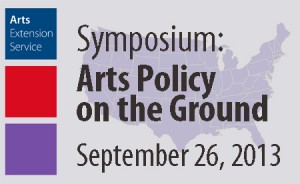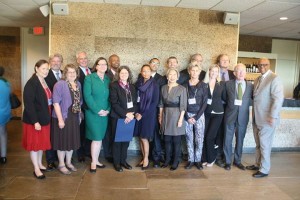Community engagement across disciplinary boundaries
06 December 2013 – Katherine Garland
For most of my experience as a public-historian-in-training, I did not often think about the arts in any purposeful way. I played in an orchestra from elementary school through college, have a not-so-secret love for musicals (my roommates are probably tired of hearing me sing Disney songs in the shower!), and enjoy visiting art museums as much as the next person, but I would not consider myself an artist. After all, my formal training is in history. This all changed last year when I decided that I needed some practical management skills in order to feel confident about running a historical organization after graduation. To learn about financial management, strategic planning, development, and the like, I decided to pursue a certificate in arts management at the University of Massachusetts Amherst to complement my public history degree. I felt like a bit of an outsider in the Arts Management Program. Everyone that I met at the Arts Extension Service (AES) organization on campus that runs the arts management program was lovely, but I did not necessarily feel like I was part of that world.
My perspective changed on September 26, when I attended the Arts Extension Service’s conference titled “Arts Policy on the Ground: The Impact of the National Endowment for the Arts.” First, we had a lot to celebrate. Not only is AES commemorating its 40th anniversary, but the National Arts Policy Archives and Library (NAPAAL), which will be part of the UMass Special Collections and University Archives, is opening this year as well. NAPAAL currently contains publications and research reports from the National Endowment for the Arts, records from the Arts Extension Service, and will soon also include papers from Americans for the Arts as well as the National Assembly of State Arts Agencies.
And second, as I participated in session after session about NAPAAL, AES’s history, public art and design, and public participation in the arts, I realized just how much public historians have to learn from arts management and vice versa. I am not the first to realize this, obviously, as artists and historians have worked together for years. Most recently at UMass, Robert Cox, director of the UMass Special Collection and Archives, worked closely with the Arts Extension Service to acquire NAPAAL. Thanks to this partnership, researchers interested in arts policy in the US will now have a place to go to discover how artists, art organizations, and politicians have worked together to advocate for the arts. By understanding the past we will begin to move on and chart a course for the future of the arts. Historic preservation professionals over time have also joined forces with artists. Public artists use their design skills to create beautiful buildings and landscapes, thereby improving our cities. But when the art starts to crumble, artists and preservationists work together to preserve important architecture, murals, sculptures, and other public art. And, of course, art and history museum professionals have a long history of working together.
But arts management and public history overlap in other, perhaps less obvious ways, in that each must deal with questions of community engagement and public participation. In public history, we must always ask ourselves: “Who is our public?” and “How can we reach that public?” The arts ask the same questions. During the Public Art and Design portion of the program, public art community leaders discussed the difficulty of determining who the community is and how to give the community a voice in public art decisions. If a work of art is going to drastically change the landscape, the community must be involved. The artists need to listen to people’s concerns in order to design the most meaningful public spaces possible. Thus arts organizations at the local, regional, state, and federal levels experiment and try to determine how to best reach their communities. Public historians do the same.
The arts and public history also face similar declines in interest and attendance. The 2012 Survey of Public Participation in the Arts (unveiled at the Symposium by NEA Research & Publications Director Sunil Iynegar) shows that art attendance, book reading, arts consumption, art making, and art learning are all on the decline. In order to address this situation, arts managers are asking, “Why do people participate, and what are barriers to participation?” Rather than grieve that interest in the arts is dying, artists are working to make traditional institutions more relevant to a changing audience. By compassionately listening to the needs of their audiences, arts organizations are able to create programming that brings in new and younger participants. I could not help but relate this example to Roy Rosenzweig and David Thelen’s landmark study, The Presence of the Past. Using a telephone survey in the early 1990s, the pair showed that Americans are deeply interested in the past and concluded that public historians need to better understand what interests people in order to better engage them. The public enjoys art and history, and arts managers and public historians need to meet the needs and interests of those audiences.
During the Public Participation in the Arts segment of the AES conference, panelists noted that many Americans remember being profoundly changed by a museum visit as a child and that age seven seems to be a magical time for exposure to museums. Seeing a work of art or dressing up in a historical costume can change the course of a child’s life. Museums matter. The arts and humanities matter. To remain relevant, artists and historians need to work together. We cannot lament that Americans are bowling alone, as Robert Putnam lamented in his influential 2000 study titled Bowling Alone: The Collapse and Revival of American Community, and choosing not to participate in public activities if our institutions and disciplines bowl alone as well. We would be much more effective as public historians and arts managers if we collaborated more often, sharing both our successes and failures and teaching one another about community relations and public participation.
From now on, when I explain to friends and colleagues that I am getting a degree in history and a certificate in arts management, I will not simply talk about the management part of my certificate, referencing its practical utility. The arts part matters, too. I’m a public historian who wants to work with and advocate for the arts. And I hope that in return, artists will do the same for the humanities.
~ Katherine Garland is a second-year Public History Masters student at the University of Massachusetts Amherst where she is also pursuing a Certificate in Arts Management. She received her BA in History from Messiah College in Grantham, PA in 2012.






Test
This well-crafted, valuable article full of keen insights. I passed this article on the Historical Society where I now live, and suggested that it is a MUST read for ALL of the board members and volunteers. The author is SO correct with her observation that the community must have a stake in the process, so that projects be successful!